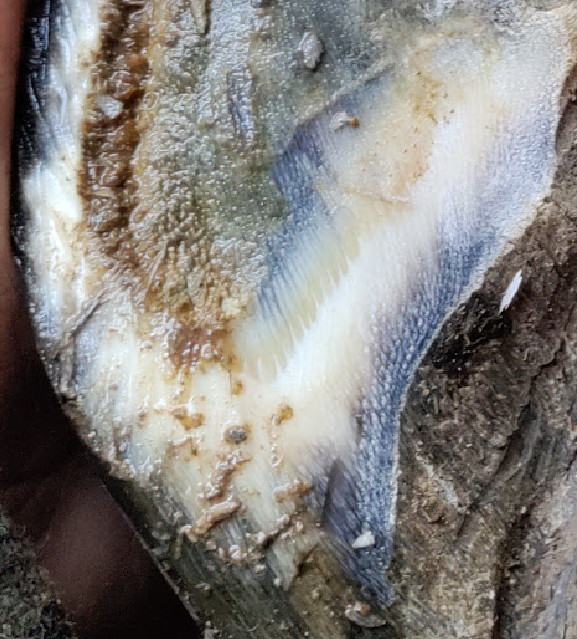What even are they and where are they each borne from?
“What are they?” is a very technical question. I want also to know the molecular makeup of each.
“Where are they borne from?” is equally technical. Do they all exude from the coriums, tubules…? I’m guessing that the laminar serum exudes from the laminae, most likely the terminal laminae that grow from the lowest point of each sensitive lamina, creating the ‘white’ line.
Cheryl Henderson, creator of the ABC trim examines sole material by taking a very thin sliver and folding it. She maintains that if the sliver after having been folded, springs back open, then it is bar material. If the sliver after having been folded, retains a crease, it is sole material. A trimmer friend had mentioned Cheryl’s “beetle experiments” to me during a conversation on soles. So I went to the ABC page on Facebook and searched for them. Her photos show hoof capsules that were left in containers of flesh eating beetles that she uses to clean bones. The beetles, she maintaine, would eat sole but not wall. Some of the capsules had slabs of uneaten material over varying parts of the sole plane. While I found the studies interesting, and can see how one might come to the conclusion that what was left on the sole was migrated bar, I’m still not convinced.
Yesterday I took some slivers from the hard grey sole on my geldings feet. When I folded them they sprang back open in just the way, as it’s said by Cheryl, that run forward bar does. When I look at them under the microscope top lit, they appear gray. When I look at them bottom lit, they are not gray but ruddy/brown/amber with brighter flecks of blood in spots. The tubules in these sections also seem to be very shallow in angle.
It’s my theory that healthy sole grows at the same angle as healthy capsule, and when it is at this angle. And when sole grows at an optimal angle, there is an inter-tubular wax exuded from some part of the sole corium/papilae. And when the sole tubules are forced into a more shallow angle of growth, they cannot function the same. And due to being much less stiff than wall tubules, they lay over due to compressive forces and at this sub optimal angle the corium/papillae can no longer exude the waxy substrate. It’s at this point, in the absence of that substrate that something else get exuded in it’s place, or maybe not, maybe this hard, (at least sometimes) grey sole is just what happens in the absence of waxy substrate. It may be blood or blood filled lymph, or that orange serum that sometimes presents on some soles when unhealthy.
I’m trying to find a lab that will do some histology on samples in order to further my understanding. The white sole sliver I took off my horse when folded, holds it’s crease. The grey sole when folded springs open. But I’m not ready to believe that it is bar material that is run forward. On these same feet, when I trim bar to sole level I can see very clearly the white line and the evidence in the laminar serum of the bond of laminar serum and insensitive laminae. And there is no evidence in this white line of bar tubules crossing over it.
But bear in mind, this is just the first flush of my looking at all this. I wouldn’t be surprise if there’s not more to see that’s I’ve not seen yet.
Somethings going on, I just don’t know what, yet…

